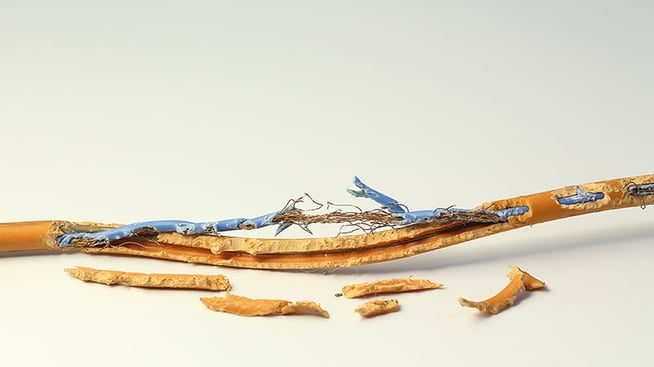Cable Assemblies can be used in almost any environment, but some environments pose specific challenges that need to be individually addressed. One such environment is when a cable assembly is installed in areas highly susceptible to rodent damage. Installations requiring rodent protection can include any outdoor application, indoor industrial installations, residential applications, food/grain storage areas, or any area that offers shelter and food for rodents.
What Attracts Rodents To Cable Assemblies?
Rodents are attracted to cable assemblies for several reasons. The covering of the cable used in the cable assembly offers an excellent surface for the rodent to gnaw on due to the presence of plasticizers, aromatic odors given off by the insulators themselves, the bright colors used for the sheaths, and the texture of the jacketing materials.
All rodents have four incisor teeth that grow continuously throughout their lives. To keep these incisors short, rodents have the constant urge to gnaw/chew. If readily available dietary products such as hard-shell nuts are not available, rodents will turn to other articles in their environment, such as cable assemblies, to fulfill the urge to gnaw.

Rodent Chewed Cable
Cable Manufacturing Methods That Repel Rodents
There are several methods to protect cables from rodent damage and ultimately discouraging rodents from chewing on the outer surfaces of a cable assembly jacket. Those methods include surrounding the cable with a physical barrier, the use of lethal toxins (poisons), the use of repellants, or the use of non-lethal chemicals.
Armored Cable Assemblies
Physical barriers consist of conduits and armoring tapes. These barriers are typically designed to prevent a rodent from gnawing on a cable by either increasing the diameter of the cable to a point where the rodent cannot get their jaws around the barrier to effectively chew the barrier or in the case of a steel armor tape being stronger than the rodents teeth and not allowing penetration into the core of the cable underneath it. Issues with physical barriers are the increased weight, diameter, and stiffness that make installation difficult if not impossible. The increased costs associated with additional material and labor to install/apply the physical barrier and the sharp edges associated with steel armor, can impair the safety of the people installing and working with the cable.
Non-Lethal Chemicals (Recommended)
The most effective method of controlling and preventing rodent damage of a cable assembly is through the use of repellants. Repellants consist of techniques such as the use of non-lethal chemicals.
The repellant package is added to the outer sheath of the cable when it is being extruded and offers long lasting effectiveness due to the controlled release of the active ingredients, with an expected release life of 10-15 years. The ingredients, such as capsaicin, cause the sheath to have a hot/spicy/bitter taste which discourages the rodent from gnawing on the cable. The smelling sense of rodents is superior to humans, so the repellant package also includes chemicals that give off an unattractive odor, not detectable to humans. The combination of taste and smell is unpleasant but is nonlethal to the rodent.
Lethal Toxins (Not Recommended)
Lethal toxins or poisons are meant to be ingested by the rodent causing death. From an environmental aspect, the use of poisons is highly discouraged. Poisons are hazardous to children and pets that may accidentally ingest the poison. Other effects of poisons are secondary effects caused by animals who consume the poisoned carcasses which will prove to be toxic to the consuming animal. The use of poisons is highly discouraged in any application.
What Is Your Best Option?
If the cable assembly that is being designed is expected to be used where there is a possibility of contact with rodents, the inclusion of a repellant package in the outer jacket is a safe and effective way to protect the cable assembly. A repellant package is environmentally safe and causes no long-term effects to the rodent and is effective in preventing rodent damage to the cable assemblies.
Summary
Rodent damage poses a significant threat to cable assemblies in various environments, including industrial facilities and outdoor installations. Rodents are attracted to cable jacketing materials for their texture, odor, and even color, and their constant need to gnaw makes cables an easy target. To mitigate this, manufacturers use several protection strategies, including physical barriers, lethal toxins, and repellent chemicals. While physical barriers such as conduits or armor can be effective, they increase weight, cost, and installation difficulty. Poisons are strongly discouraged due to their environmental hazards and risks to other animals and humans.
The most effective and environmentally safe solution is to incorporate non-lethal chemical repellent packages into the cable sheath during manufacturing. These additives, often using ingredients like capsaicin, create an unpleasant taste and odor that deter rodents without harming them, providing long-term protection and reliability for cable assemblies in rodent-prone areas.
Key Takeaways
- Rodent attraction is natural and constant: Rodents chew on cables not only for odors and textures but also to wear down their continuously growing incisor teeth.
- Physical barriers have trade-offs: Armoring and conduits can prevent chewing but make cables heavier, stiffer, more expensive, and harder to install.
- Poisons are not viable: Lethal toxins present safety risks to humans, pets, and other wildlife through direct or secondary poisoning, making them environmentally unsafe.
- Repellants are the preferred solution: Embedding non-lethal chemicals like capsaicin into the cable sheath deters rodents effectively while being environmentally safe and non-toxic.
- Best practice for rodent-prone areas: For installations in environments with high rodent activity, incorporating a repellent package into the cable jacket provides long-term, reliable protection without ecological harm.















